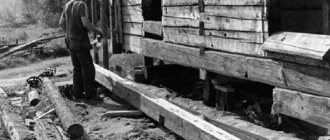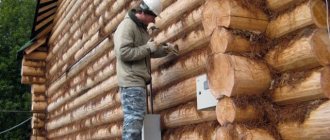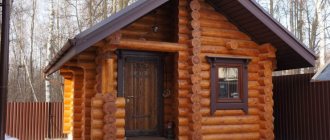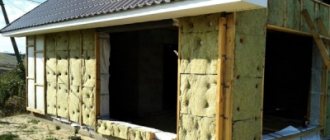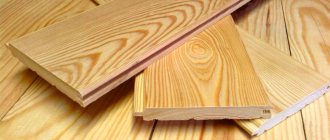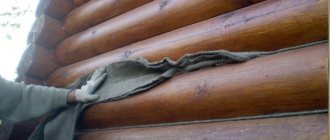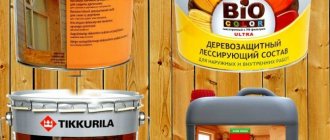I am glad to welcome my reader again!
Today we’ll talk about how to paint a log house? In general, I would say this: paint it a different color or preserve the original texture of the log house. Even if in some places with areas darkened by time and other external natural defects, but preserved in an authentic form. The topic is: how to paint the outside of a bathhouse frame and be satisfied with your work for many years?
Just in case, be mentally prepared for the fact that after painting you will not see exactly what you saw on the salesperson’s display board in the store. Somewhere the shade is not the same, roughness is possible, and the paint consumption, as a rule, exceeds what was promised. Let me reassure newcomers - this is a common reaction.
They paint ideally only in television advertisements... remember, they will run a brush or roller over the wall and immediately get a beautiful solid color. But this is the merit of the cameramen, not the paint manufacturers or plasterers. And in life, there are always “pleasant” nuances.
Why do you need to paint the outside of a wooden bathhouse?
- For protection against weather conditions. Sun, precipitation, wind - all this does not improve the tree;
- To protect against temperature changes emanating from inside the bath, which also affect the durability of the material;
- For protection from various biological lesions;
- For a more aesthetic appearance.
Points 1, 2 and 3 serve to extend the life of the wood base, and this is the main thing. And point 4, for some, is a controversial point. Someone will say, how can the color of paint be better than the texture of natural wood...
Painting of the log house must be preceded by the application of a primer coating, an antiseptic and a fire retardant compound (pyrine retardant). It is important. The antiseptic will create protection against wood insects, fungal mold, rotting and other things, antipyrine, and increase the fire resistance of the structure. Both substances can be chosen either in the form of a colorless substance or an enriched color.
By the way, there are some paints that contain antiseptic and water-repellent impregnations. According to many experts (who always play it safe), it is better to perform priming as a separate process.
And after sanding (when the wood loses its roughened layer and becomes easily accessible to all kinds of biological damage), this must be done immediately.
Before treating with protective substances, you need to check the quality of the log caulk and, if necessary, bring it into compliance. It is worth considering that the ends of the log house absorb moisture more strongly and therefore it is recommended to apply two or three additional layers to them.
Another way to protect a sauna stove from negative influences
You don’t have to think about how to paint an iron stove in a bathhouse, since not only paint can protect it. The method of metal bluing, which involves creating a chemical reaction, is widely used.
First the surface must be cleaned. To do this, use a 5% sulfuric acid solution, which should be applied with a brush. Then the laundry soap is diluted in water in a ratio of 50 g per 1 liter. This solution must be used to wash off the previously applied sulfuric acid. Next, the oven is heated to 150-180°C and treated with caustic soda diluted in water in a ratio of 50 ml per 1 liter. The composition should be applied only by spraying to avoid splashing.
Conclusion
In order for the stove to serve for a long time, it must be well treated, and for this you should make the right choice of what to paint the stove in the bathhouse with. The solution to this issue should be taken with full responsibility and there is no need to save money, because the stove is the main component of the bathhouse.
How to prime the log house?
Of “our” “priming” products on the market, I would like to highlight Neomid. What distinguishes it is good quality and reasonable price. The line of products for wood allows you to “close” almost all needs: Fire protection, bio-antiseptic, moisture protection, etc. Reviews for the brand are good.
Another Russian manufacturer, the Senezh company, which produces a rich line of products. The assortment includes several protective compounds for different purposes (I mean, intended specifically for outdoor woodwork). In addition to primers, there are varnishes and paints on an organic and synthetic basis (acrylate, oil, etc.).
What paint can I recommend?
Even after choosing the type of paint you want to use in your bathroom, choosing a specific brand is not easy: there are so many different offers. Therefore, it is easier to navigate if there are recommendations from those who already have some experience in using painted walls in the bathroom. Here are the paints that have good reviews:
- Caparol Capamix Samtex 20 (latex paint).
- Livna PS 285. Washable paint for heavily loaded walls (use not in areas exposed to water).
- Dulux Ultra Resist (acrylic).
- Benjamin Moor (Benjamin Moore) Kitchen & Bath Satin Finish (acrylic); Aura Interior Matte Finish (silicone).
- Rainbow Extra (acrylic).
- Tikkurila (Tikkurila). There are several options: Luya 40 (acrylate for wet rooms), Luya 7 (washable acrylate for areas with high loads), Euro Extra 20 (semi-matte),
- VGT Kitchen and Bathroom IQ130 (acrylic).
There are many other paints, but these have already been used in bathrooms, so they are already tested. These are mainly acrylic paints; others are apparently used less often, since they are more expensive. All of them provide a matte or semi-matte finish - this is the latest trend in decoration. The advantage of this choice is that surface defects (if any) are not as noticeable as on those painted with glossy and semi-gloss paints.
A few final photos of how you can paint a bathroom - for inspiration.
Blue tones are often found in the bathroom
Beige bathroom paint is a classic choice.
Lighter shades require less light
It is not necessary to paint the walls the same color. Use your imagination
The combination of tiles and painted walls is the most practical option
Sunny orange color of bathroom walls
Cheerful green in two shades in the bathroom
Even if the interior is not luxurious, painted walls in the bathroom look good
How to paint a log house?
The lower crowns are treated with waste oil.
Let's divide the materials into two types: folk and modern. First, I will give a few folk recipes. What if someone wants...
Waste machine or transformer oil
Yes, the smell is not very good, but it will disappear after a while, but the impregnation will remain and will create a waterproof layer. Although dust sticks to it “freshly”. Apply the oil with a rough brush and rub in thoroughly.
Turpentine and wax
Mix in equal proportions. In addition to protecting against moisture, this composition provides good protection against wood insects and gives the walls of the log house a certain gloss of “well-kept antiquity.” Particularly suitable for painting baths “in years”.
Oak bark decoction
A nice darkened background, however, the wood pattern is clearly visible through it. An old and forgotten method.
It is better not to make coloring compositions from onion broth (these are not eggs for Easter). Yes, they give the logs a pleasant shade, but as an “undesirable bonus” they have a smell that attracts insects.
My opinion is that you shouldn’t get carried away with environmental products. In a number of ways, it is no longer easy for them to compete with the products of the chemical industry. But if you are a principled supporter of natural raw materials, then, without a doubt, go ahead!
Design
We haven’t touched on this topic before, but why not really think with you about what color to paint the bathhouse and what design options there are in general?
What color to paint
We have paints and varnishes at our disposal. The bathhouse itself is either made of wood, or lined with wood, or brick, or plastered. Perhaps it is finished with stone, for example, on the foundation.
In general, it would be desirable to maintain at least some kind of stylistic unity - at least within the bathhouse itself, and at maximum - in all buildings. That is, if you decorated the house traditionally and in natural wood colors, then painting the outside of the bathhouse pink will look... foreign. But if all the buildings on the site are bright in color, then the bathhouse should be made no less bright.
Now about the styles. We have already said once in other articles that the bathhouse has three conventional styles: tradition, high-tech and “modern” (the latter means the use of modern materials without particularly advanced design ideas).
If you choose “tradition,” then you either have timber, a log house, or lining - paint in shades from yellow through orange and reddish shades to dark brown, better with varnish than paint, so that the texture of the wood is visible.
It’s hard to believe in real “high-tech” in a summer cottage. And if it is implemented, it will be according to a design project, where all the colors will be painted.
There is only one option left - the same “conditionally modern” style, which does not have its own face. Try to “revive” it by using brighter colors. And regarding the combination of colors, we advise you to search the Internet for pictures with the phrase “color schemes” - usually this is a photograph from which several colors have been extracted (stripes under it), forming a harmonious combination. It's easier than learning color theory.
Example of color gamut extraction
Now I turn to modern materials
I will talk about those that are intended specifically for wooden buildings.
Belinka
The Belinka brand has long proven itself well. The range includes not only paints, but also varnishes, various impregnations, and glazing compounds. The range of shades of varnish and paint is very colorful, allowing you to preserve the texture of the wood, emphasizing it with a decorative background. Belinka polyacrylate paints create a film on the surface of wood that, on the one hand, has water-repellent properties and, on the other, is vapor-permeable.
Tex
Professionals speak positively about the Russian manufacturer Tex. In addition to paint, the company has several types of antiseptics, including ground and glaze, drying oils, fire retardant impregnations and wax-based compounds.
A separate point that is often not paid due attention: the protection of metal parts. Heads of nails and screws, hinges, corners, etc. are susceptible to corrosion. For protection, special compounds are used. The same Neomid has them.
Tikkurila
If finances allow, contact the Tikkurila brand, respected in Russia. The paints of this Finnish manufacturer have been tested in the harsh conditions of the northern climate. They contain components containing various additives that prevent the formation of rot, moisture absorption, and protect against ultraviolet radiation.
You can choose from acrylate paint called Pica-Techo, oil Techo, polyacrylate, Ultra-Classic. This brand, in addition to its relatively high price, has another drawback - names that are difficult to remember. Here they are.
And of course, the Finnish company has all EU certificates confirming environmental friendliness.
By the way, if the coating of the log house was done with oil paint, then the next coating (for example, after 3-5 years) should also be done with oil paint.
In general, recommendations for painting a log bathhouse boil down to what needs to be taken into account:
- Firstly: the better (that is, more famous) the manufacturer, the better and more durable its primer and topcoats;
- Secondly: use special-purpose compounds, in our case, intended for external wooden walls. If you find among well-known manufacturers special paints for facades made of rounded logs, it will be even better, but, unfortunately, I don’t know such paints.
Saikos
Finally, let’s touch on the German manufacturer SAICOS. The catchphrase - “True German quality” is very relevant to this day. The main feature of this product is that the base is only natural oils and waxes. The conclusions here are simple: such wood impregnation will preserve your structure for many, many years. In a word - I recommend it. I think that professionals will understand me...
Varnishes and paints
Paintwork for log houses can be divided into 2 classes according to the range of paints:
- Professional - consist of 3-4 layers of emulsions and solutions of different compositions with different penetration depths, as well as special application methods. Such coatings are complex in design and expensive in materials. Knowledge of the technological map of coatings is required.
- Construction and household - consist of 1-3 layers, usually from one material. This class is universal in use, and the price of materials is closer to the average range.
Glazing composition for finishing a wooden bathhouse outside
Water based
Let's consider water-soluble glaze acrylic paint-varnish.
It contains:
- clear nail polish;
- opaque paint;
- acrylate dispersion.
Simply put, when choosing how to paint the inside of a bathhouse, you need to purchase a transparent composition with pigment impurities. The natural structure of wood has different absorbency of its different parts, so its pattern appears on the surface. Today, this material is the best means for painting a log house from the inside, if the surface is smooth, new and beautiful.
Remember, do not use glazing compounds (a thin layer of paint) consisting of drying oils and oils on oak or oak veneer surfaces. Due to the chemical reaction of vegetable oil with substances located in the fibers of its oak wood, permanent stains are formed. It is better to combine such materials with spruce or pine.
Oil
Haven't decided what to paint the walls in the bathhouse with? Try linseed oil, which, however, is rarely used in its pure form, since it is quite difficult to coat the wood with a viscous liquid. Usually it is diluted with your own hands with turpentine 1.5:1. After the latter evaporates, only oil will remain on the surface.
Turpentine-linseed oil for wood impregnation
Turpentine is an “extract” from coniferous trees, which is sometimes used to create aroma in a bathhouse.
Instructions for applying this mixture are provided:
- heat the mixture to 50°C;
- apply it to the surface in this form with a soft brush or rag in 2-3 layers;
- Clean the pile with sandpaper after the mixture has dried.
The oil itself is transparent, however, you can add a little dry coloring pigment to it. The process is called glazing a wooden surface.
What to choose from
When choosing how to paint the outside of a bathhouse, pay attention to the compositions for painting a bathhouse inside and out, often discussed on the Internet, below. Therefore there are no first or last places here
It should also be taken into account that large companies often create subsidiaries, but under different brands.
Acrylic paint for exterior use “Belinka”
For example, the Finnish Tikkurila has Vivacolor and Biotex, which few people know about, so consumers will be waiting for the same paint for another package.
- Austria - "Adler".
- Czech Republic - "Belinka".
- Russia – “Aquatex” and “Rogneda”, “Neomid” and “Senezh”.
- Poland - "Vidaron".
- Finland - Tikkurila.
- Europe, Finland and Denmark - Pinotex.
Antiseptic paint "Aquatex"
Recommendations for finishing the inside of a log house
- Do not rush to apply paint to structures made from naturally damp logs. Wait until this parameter drops to 20%. Wood dried to such a limit will not interfere with the normal absorption of glazing compounds, impregnations and primers.
- Treat the frame outside and inside during the drying period with a preservative antiseptic so that it does not deteriorate. Cover the ends to dry evenly and wait 6 months until the building has 20% humidity. Only then begin work indoors.
By the way, in Scandinavian countries they have long stopped covering logs with transparent compounds that can emphasize the structure of the material. Customers ask to coat the log houses outside and inside with dull paints, doubling the service life of the coating.
In the photo - painting the outside of the bathhouse using a spray gun
Types of paints
Few people think about the fact that each country is trying to promote its own compositions to the market of countries similar to its climate (find out also how to paint the floor in a bathhouse).
For example, in North America (Canada and USA) manufacturers work mainly on paints suitable for northern latitudes, in Germany - for warm winters (up to - 10˚C), and Finns - only for their weather conditions. Therefore, often when purchasing an “overseas” product, we end up getting a completely different result than we expected.
Features of the choice of impregnations
To treat the internal space of a timber bath, you should choose mixtures that will provide, or rather, maintain high environmental friendliness of the structure, and also will not damage the environmental qualities.
However, this rule also applies to those mixtures that are used externally. If we talk about the treatment of steam rooms and showers, it is advisable to use special compounds with wax and water, as well as acrylic varnishes.
Attention should be paid to vapor permeability and the absence of toxic elements. Regarding vapor permeability, it is better to choose products that have this parameter of more than 50%. In this option, the entire surface is perfectly protected from moisture: water is not absorbed into the walls.
Application
Can the floors be painted?
Can. Moreover, if we are not talking about a steam room or a washing room, you are generally not limited in your choice. But even the steam room and washing room are no exception - if you use specialized dyes or impregnations.
The floor in the steam room is the zone of least heating, and this applies even more to the sauna, because there the air flow is usually through the bottom of the entrance door, and cold air spreads along the floor, cooling it. In a Russian bath, everything is sealed to the maximum, but there and in the working area the temperature is low, so the floors have a low temperature in both cases.
We have already written about whether it is possible to paint the floors in a bathhouse with paint. However, we consider it possible to repeat that all options come down to oil impregnations (the Finns are not afraid that it will be slippery), as well as acrylate compounds (see Tikkurila products above).
In fact, if you want to paint the floor in the steam room and washing room, use the most environmentally friendly compounds - those that dissolve in water. For example, acrylic bath paints mentioned above.
Walls
There shouldn’t be any problems with this at all, because for the floor you still need to somehow select a composition with the greatest wear resistance, and for walls any composition is suitable - paints, varnishes, impregnations, any composition (preferably harmless).
How to paint stoves, boilers, tanks?
In general, it is correct that all equipment associated with heating water needs protection from corrosion, and certain paints and varnishes can help with this. You just need to figure out what exactly is suitable for these purposes.
For a metal stove
The temperature in the stove depends on the combustion temperature of the wood. Firewood comes in different types of wood and different humidity levels. Plus, another important point is air access: the more air there is, the higher the flame temperature.
Let’s assume that the combustion temperature, which varies somewhere from 500 to 1000 degrees “ideally” (that is, dry ash firewood, for example, with sufficient oxygen), in reality is 600-800 degrees (if you don’t burn it with poplar) . In this case, you should focus on paint with heat resistance of 650 degrees.
In general, either measure the temperature of the furnace with a thermometer, or somehow be guided by the color of the metal's heat (there are tables where the shade of red is converted into degrees, but, of course, it is difficult to determine the shade by eye).
In addition, there is a useful video that tells you exactly what kind of paint and how much paint you will need in your work:
For boiler
The choice of paint for your sauna boiler depends on what type of fuel you use to heat it. Coal burns at a higher temperature than wood. Ideally - at 2000 degrees, in reality - at 1000. Therefore, the boiler should be painted with paint that can withstand up to 1000 degrees.
For hot water tank
The hot water tank does not heat up above the boiling point of water. Therefore, the paint for a hot water tank in a bathhouse can be exactly the same as that used for painting radiators. Although, if there is anything left from painting the stove, you can use that too.
Types of coatings
The outer coating of any structural material can be multi-layered. Moreover, each layer can have its own purpose. On the other hand, composite formulations are now being produced, “in one bottle” containing substances that can be applied separately. In particular, we are talking about paints in which, for example, an antiseptic is added.
Let's analyze each of the possible layers separately.
Antiseptic
Used to protect buildings from mold and other types of fungi, putrefactive bacteria and insects. It is logical to assume that the main purpose will be to protect wooden structures , but in fact concrete also needs to be treated with an antiseptic, because fungi reproduce successfully on it.
First, let's mention the antiseptics that are sold for wood . Most often they are primers or glazes. You can also find individual antiseptic compositions either water-based, fat - based, or based on organic solvents.
In addition to mushrooms, antiseptics successfully deal with insects - if bugs are the main problem, you can buy a product aimed specifically against them. Or this will be one of the options for a more universal tool.
Primers, as the name suggests, are not a finishing coat. This is a composition designed to perform several functions at once, starting with the bioprotection of the surface being coated and ending with improving the adhesion between the finishing coating and the source material.
Lazuli is a special type of coating that can be a finishing coating, but differs from varnishes and paints in that the latter are necessarily film-forming, while glaze has varieties that would be more correctly called impregnations, because they penetrate deeply into the material without leaving film surface. (At the same time, there are film-forming glazes - it depends on the consistency.)
We have already said that the main difference between painting the outside and inside of a bathhouse is:
- toxicity of the products used;
- their resistance to aggressive environmental factors (precipitation, ultraviolet radiation, temperature).
Antiseptics are also used inside buildings, but there are more stringent sanitary safety requirements for them. And outside you can use more toxic, but also more effective means.
BY THE WAY! There are combination preparations that provide both bioprotection and fire protection.
Fire retardants
Fire retardant for interior and exterior treatment
There are many contradictions in the bathhouse. On the one hand, this is the most frequently burned building according to statistics. But protecting its most vulnerable part - the steam room - from fire can only be done with ordinary screens and heat insulators, and not with substances that prevent the wood from catching fire.
And all because fire retardants - substances that prevent fire and combustion - are not useful for humans. Usually these are boron or urea salts. It would be very good to treat the wood next to the stove with them, but this is exactly what you shouldn’t do, because the high temperature makes many substances volatile, and they will settle on the skin and get into the lungs...
But if we can't protect the area around the stove, is it even worth spending money on fire protection? Costs. There is nothing stopping you from treating the attic where the chimney runs (and it gets very hot), as well as the places where electricity is wired, with fire retardants.
Painting the outside of the bathhouse with fire retardant is also an option, although fires usually start inside. Actually, you can treat all rooms with it, except the steam room, if you wish.
Fire retardants are divided into two classes : some maintain defense only up to a certain temperature, others do not care about the temperature, they create obstacles to combustion - they block the access of oxygen to the tree.
When looking for protective compounds, you will come across a variety of options, including those where the topcoat may contain an antiseptic and fire retardant. However, in this case there is no need to rely heavily on such protection, because protective impregnations only work effectively in case of deep penetration , in particular, under pressure.
Varnish
There are a great variety of facade varnishes, and they are used for varnishing wood, stone, brick, and plaster .
For wood
One of the most aesthetic ways to paint the outside of a wooden bathhouse is to use varnish. However, remember that facade and interior dyes are different from each other, and you should not confuse them in application.
The main difference between exterior varnish is that it is more elastic - this property is necessary for it, since wood exposed to the environment tends to constantly change volume, gaining and releasing water. At the same time, it should be vapor-permeable, but not water-permeable.
The second important point is its resistance to ultraviolet radiation . Under the influence of active ultraviolet light, dye molecules disintegrate, and the dyes themselves lose the properties declared by the manufacturer. Therefore, it is better to take a composition with UV protection.
Many trains have both interior and exterior modifications. Therefore, below we provide a table with the properties of the main types of varnishes:
For stone, brick and concrete
You will be surprised, but in this case the same composition is suitable for coating stone, brick and concrete. But brick, in essence, is an artificial stone, like concrete. Therefore, there will be no fundamental difference here.
On sale you will find polymer and polyurethane, as well as acrylic and silicone varnishes. The last two are water-soluble and should be used indoors.
Polymer is best suited where the goal is to make the surface waterproof.
Polyurethane significantly increases the service life of the surface, while at the same time making the colors brighter.
Varnishes make the surface of stone or brick look wet with water.
Dye
Paints differ from varnishes in that they are not transparent. This is also a good option for those who are looking for something to paint the outside of their bathhouse with.
The quality of façade paint, which is best used to paint the outside of a bathhouse, depends on the chemical composition and concentration of the substance that binds color pigments. Their composition can be different resins - acrylic, vinyl, silicate, silicone. And the higher their concentration, the better the paint.
ATTENTION! In cheap paints, some of the binding resins are replaced with fillers.
The quality of the paint also depends on the presence of UV protection in it, on vapor permeability of at least 130 g per square meter per day, but at the same time with minimal water permeability. (Roughly speaking, the paint should “breathe” and not allow water to pass through.) In addition, such wear resistance is good, which will allow for at least 5 thousand cleanings of the surface during cleaning.
IMPORTANT! Paint consumption is usually from 100 to 300 grams per layer per square meter of surface. The higher the hiding power, the lower the paint consumption. The smoother the surface, the lower the consumption, again.
On sale you will find:
SILOKSAN is a water-borne, silicone emulsion-based mineral surface paint,
an ordinary cheap water-dispersion - a solution of PVA and pigment, to put it simply, but it is also called vinyl or polyvinyl acetate. It is characterized by: mechanical and chemical damage, shrinkage during drying, and the possibility of infection by fungi.- acrylic and acrylic-silicone (the latter today is called latex). They are not particularly cheap, but they are quite good, so you need to make a decision based on the specifics - how suitable this coating is for a particular surface.
- silicone - based on silane or siloxane, they are distinguished by very high water-repellent ability on the outside and good vapor permeability when vapor moves from the inside. Something like a membrane. Significantly increases the durability of the surface covered with them. They also have high adhesion.
- limestone - suitable only for coating plaster, have antiseptic properties.
- silicate - based on silicon compounds (liquid glass), very durable, with good adhesion, not afraid of fungi and insects, indifferent to temperature fluctuations and precipitation.
- polysilicon - an improved version of the previous class. Also called silicate-ash. They are good for painting plaster made of cement or cement with lime.
- cement - a mixture of white cement with pigment, plus additives. It is characterized by both high vapor permeability and high water absorption.
You can learn more about paints for baths outside and inside from this review.
Useful tips
- For the exterior walls of the log house, it is advisable to choose dark colors - this will help protect it from exposure to sunlight. On the street side, it is not at all necessary to use water-based paint; you can also use it containing alkyd resins (based on a chemical solvent).
- It is better not to treat the steam room with glazes and paints, because this room has the highest temperature and humidity. For this purpose, you can use water-resistant, heat-resistant acrylic varnishes based on water. Their use will protect and emphasize the structure of the wood, avoid a strong odor, and make it possible to touch the walls without the risk of getting burned.
- In the washing room, it should be taken into account that here all surfaces often come into contact with hot water and steam. This makes them vulnerable to rot and insect pests. Before painting, this room must be treated as thoroughly as possible with an antiseptic.
- After impregnation, it is better to cover the remaining rooms inside the log house with varnishes or paints based on water, and not on a chemical basis.
- When choosing a protective impregnation, it is better to give preference to one that contains insect repellents.
- When painting outside walls, remember that the ends absorb paint more strongly. They can and should be applied 1-2 more layers.
- Chemical compounds must be applied only to previously cleaned and dry surfaces.
- Before you start painting the floor, it should be treated in several layers with moisture-proof and antibacterial impregnations.
These simple recommendations will help you easily cope with cosmetic repairs and significantly extend the life of the structure. If you take care of your bathhouse in a timely manner and competently make minor repairs, it will please the owners for a long time.
What to choose?
When choosing products for treating wood outside, you should be guided by the following expert advice:
- When choosing an antiseptic, you should choose compounds that have good permeability into wood. This characteristic is always indicated in the annotation for the composition. To treat the outside of a log house, you should choose an antiseptic that can protect 1/3 of the wood.
- Environmental friendliness. It is worth remembering that when making a wooden log house, the goal was to create a natural room, so there is no place for chemicals even in the exterior decoration. It is important to choose products that have safety labels on them.
- External attractiveness. When finishing the outside, coatings with glossy components will look most attractive: varnish, acrylic or oil compounds.
- Safety. It is best to choose coating products that contain flame retardants (fire retardant chemicals). This will provide the building with even greater fire safety.
Figure 4 – Painting a wooden frame with alkyd paints
Video description
About the details of the construction of a frame bath in the video:
Ventilation
The choice of ventilation system depends on where the firebox is located - in the steam room or in an adjacent room (which is designed more often, as it saves heat). Most baths have a mixed (supply and exhaust) ventilation system installed. For this they provide:
Lighting
The windows in the bathhouse are traditionally small - this helps retain heat. To increase the amount of natural light, in a bathhouse without an attic, an additional window can be installed on the roof. To organize artificial lighting, sealed lamps protected by matte anti-fog lamps are chosen.
